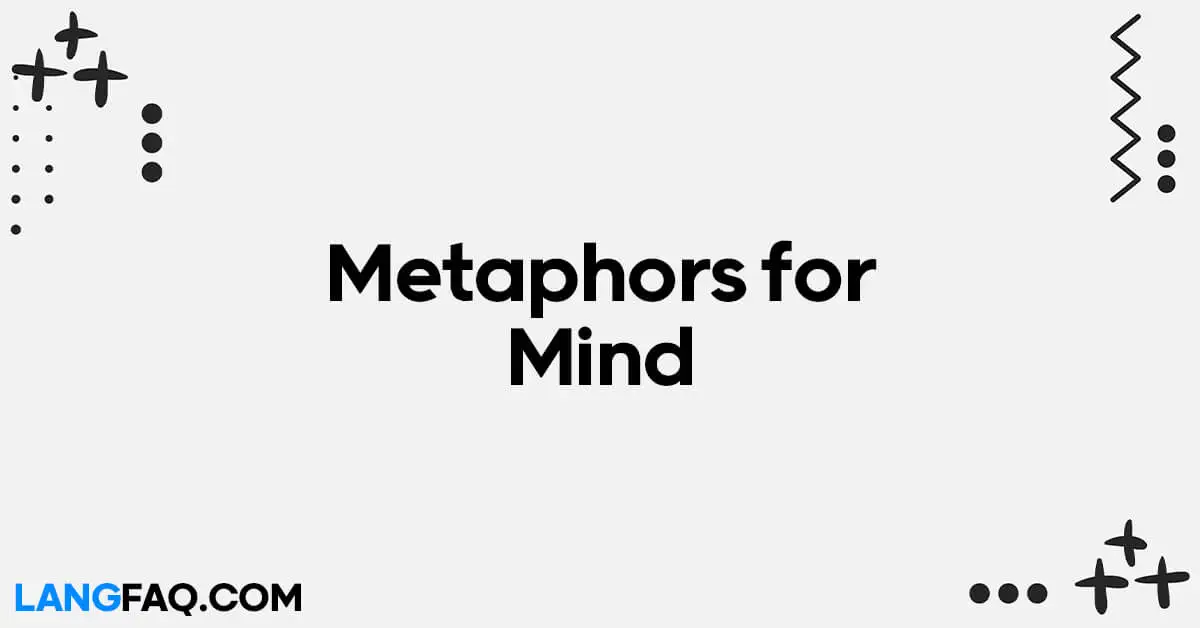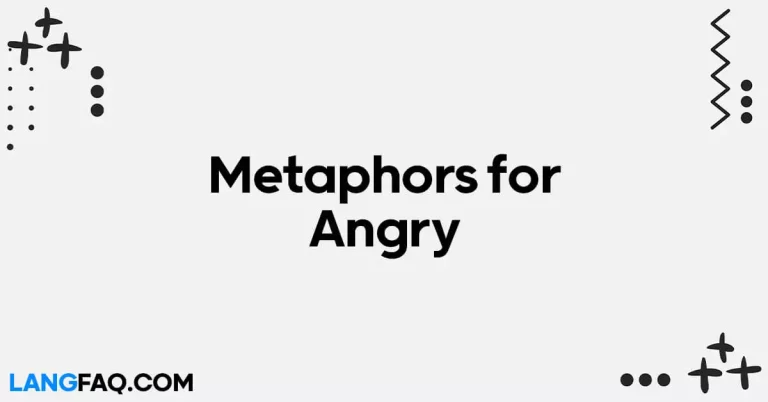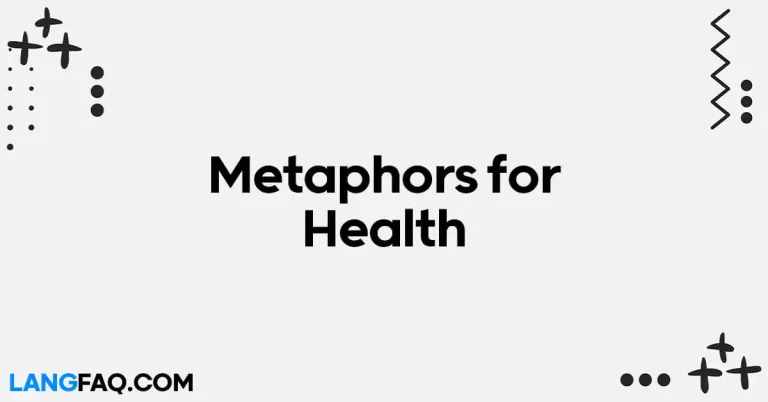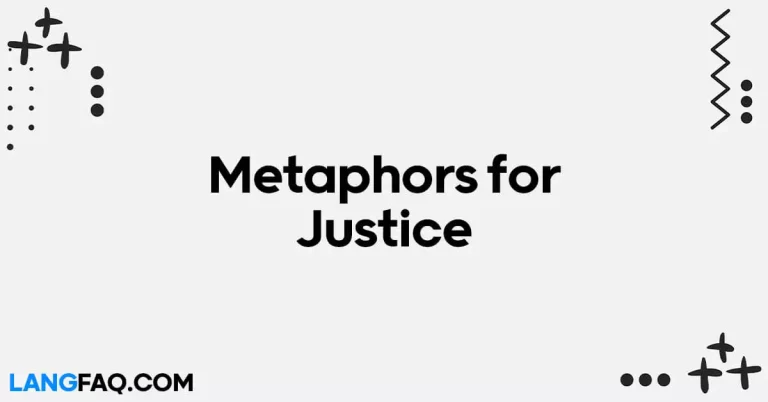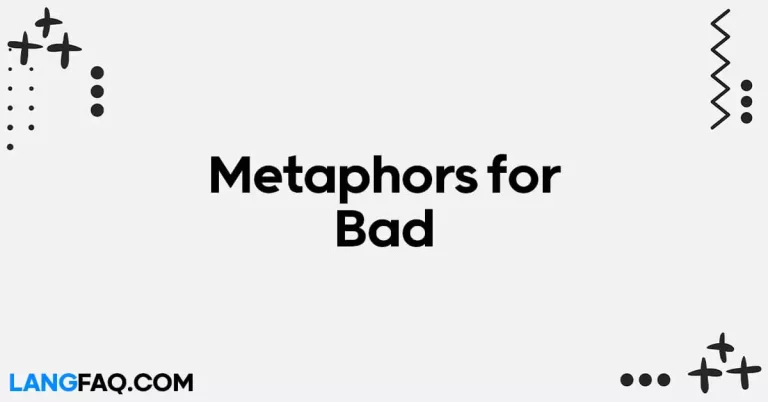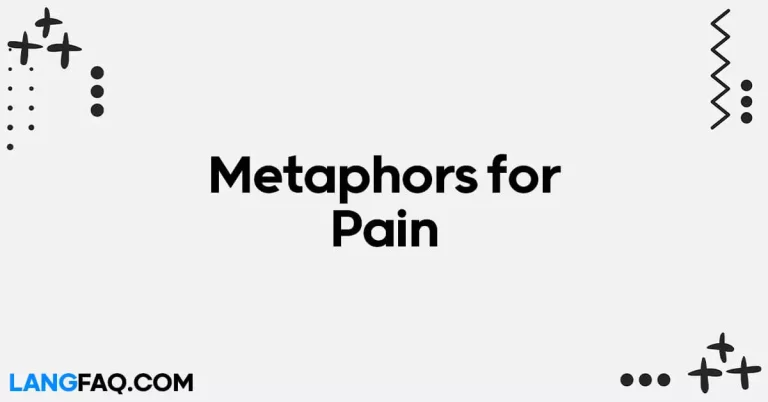The mind, a labyrinth of thoughts and emotions, often defies straightforward description. In this exploration, we’ll embark on a journey through 26 metaphors that offer glimpses into the complex landscapes of the human mind.
26 Metaphors for Mind
- The Garden of Ideas: Your mind is a lush garden where thoughts bloom like flowers, waiting to be nurtured and cultivated.
- The Symphony of Consciousness: Picture your thoughts as musical notes, harmoniously creating the beautiful symphony of your consciousness.
- The Quantum Puzzle: Like a quantum puzzle, your mind navigates through a superposition of possibilities, creating a tapestry of thoughts.
- The Mirror of Reflection: Your mind acts as a mirror, reflecting your innermost thoughts and feelings, inviting self-awareness.
- The Ocean of Subconscious: Dive into the vast ocean of your subconscious, where hidden currents of memories and desires flow beneath the surface.
- The Tapestry of Emotions: Envision your mind as an intricate tapestry woven with threads of joy, sorrow, love, and fear, creating a colorful emotional landscape.
- The Architect’s Blueprint: Your thoughts construct the blueprint of your reality, shaping the framework of your experiences.
- The Butterfly Effect of Thoughts: Consider your ideas as butterflies, where a single thought can set off a chain reaction, influencing the trajectory of your life.
- The Library of Memories: Step into the library of your memories, where each book holds a cherished moment or a valuable lesson learned.
- The Puzzle of Perception: Unravel the puzzle of perception, where your mind interprets the world through a mosaic of sensory inputs.
- The Clockwork of Cognition: Imagine your mind as a precision clockwork mechanism, with each cog and gear working seamlessly to process information.
- The Echo Chamber of Thoughts: Your mind is an echo chamber, where thoughts reverberate and amplify, shaping your beliefs and perspectives.
- The Canvas of Creativity: Envision your mind as a canvas of creativity, where thoughts and ideas transform into artistic masterpieces.
- The Mosaic of Imagination: Explore the mosaic of imagination, where fragments of ideas come together to create a vibrant picture.
- The Fortress of Dreams: Your mind is a fortress where dreams take refuge, influencing your aspirations and ambitions.
- The Starry Night of Ideas: Picture your thoughts as stars in a night sky, each representing a unique idea that lights up your cognitive landscape.
- The Chessboard of Choices: Your mind is a chessboard, where strategic thoughts and decisions shape the game of life.
- The Alchemist’s Cauldron: Like an alchemist’s cauldron, your mind transforms raw thoughts into the gold of meaningful insights.
- The Silk Road of Synapses: Envision your neural pathways as a Silk Road, connecting thoughts and ideas across the vast landscape of your mind.
- The Kaleidoscope of Perspectives: Your mind is a kaleidoscope, continually shifting and rearranging perspectives to form a beautiful cognitive pattern.
- The Beacon of Intuition: Picture your intuition as a guiding beacon, illuminating the path through the complexities of decision-making.
- The Phoenix of Reinvention: Like a phoenix, your mind has the power to reinvent itself, rising from the ashes of past experiences.
- The Blacksmith’s Forge: Your mind is a blacksmith’s forge, where thoughts are molded and refined, forging the tools of understanding.
- The Tree of Knowledge: Envision your mind as a mighty tree, with each branch representing a different facet of knowledge.
- The Weather Vane of Emotions: Picture your emotions as a weather vane, constantly changing direction and intensity with the winds of experience.
- The Virtual Reality Simulator: Your mind is a virtual reality simulator, creating immersive experiences that shape your perception of the world.
These metaphors offer a diverse and imaginative perspective on the intricate workings of the mind, providing a colorful tapestry of understanding.
| Metaphor | Meaning | Example |
|---|---|---|
| The Garden of Ideas | The mind is a fertile ground where thoughts flourish and can be cultivated. | Just as a gardener tends to plants, nurturing thoughts in the garden of my mind has led to creative ideas. |
| The Symphony of Consciousness | Thoughts and emotions blend harmoniously, creating a complex symphony within the mind. | In moments of deep reflection, I can feel the symphony of consciousness playing different emotional notes. |
| The Quantum Puzzle | The mind operates in multiple states simultaneously, much like a quantum puzzle. | Trying to make decisions sometimes feels like solving a quantum puzzle with various possibilities. |
| The Mirror of Reflection | The mind reflects one’s innermost thoughts and feelings, fostering self-awareness. | When I look into the mirror of reflection, I confront my emotions and gain a deeper understanding of myself. |
| The Ocean of Subconscious | Hidden currents of memories and desires flow beneath the surface of the mind. | Exploring the ocean of my subconscious, I discovered forgotten memories and aspirations. |
| The Tapestry of Emotions | Emotions intertwine to create a rich and intricate tapestry within the mind. | The tapestry of emotions in my mind weaves together joy, sorrow, love, and fear into a complex pattern. |
| The Architect’s Blueprint | Thoughts construct the blueprint of one’s reality, shaping experiences and decisions. | Every decision I make is influenced by the architect’s blueprint of thoughts that resides in my mind. |
| The Butterfly Effect of Thoughts | A small thought can set off a chain reaction, influencing the course of life. | Like a butterfly effect, a single positive thought can lead to a series of actions that shape my journey. |
| The Library of Memories | Memories are stored in the mind’s library, each holding a significant moment or lesson. | Each book in the library of memories tells a story, capturing the essence of moments from my past. |
| The Puzzle of Perception | The mind interprets the world through a mosaic of sensory inputs, forming one’s perception. | Solving the puzzle of perception requires understanding how my mind pieces together sensory information. |
| The Clockwork of Cognition | Cognitive processes work seamlessly, like the precision of a clockwork mechanism. | The clockwork of cognition ensures that my mind processes information with accuracy and efficiency. |
| The Echo Chamber of Thoughts | Thoughts reverberate and amplify within the mind, shaping beliefs and perspectives. | In the echo chamber of my thoughts, repetitive ideas can reinforce my beliefs and influence my views. |
| The Canvas of Creativity | Thoughts and ideas transform into artistic creations on the canvas of the mind. | Exploring the canvas of creativity allows me to express my thoughts and ideas in unique and artistic ways. |
| The Mosaic of Imagination | Fragments of ideas come together to create a vibrant and imaginative mosaic. | My mind’s mosaic of imagination combines diverse thoughts to form a colorful and creative mental landscape. |
| The Fortress of Dreams | Dreams find refuge within the fortress of the mind, influencing aspirations and ambitions. | The fortress of dreams within my mind propels me to pursue ambitious goals and turn aspirations into reality. |
| The Starry Night of Ideas | Thoughts sparkle like stars in the night sky, each representing a unique idea. | Gazing at the starry night of ideas in my mind inspires me with the brilliance and potential of creative thoughts. |
| The Chessboard of Choices | Strategic thoughts and decisions shape the game of life, much like pieces on a chessboard. | Navigating the chessboard of choices requires strategic thinking to make moves that impact the outcome of life. |
| The Alchemist’s Cauldron | Raw thoughts are transformed into the gold of meaningful insights, akin to an alchemist’s cauldron. | Within the alchemist’s cauldron of my mind, raw ideas undergo a transformative process, yielding valuable insights. |
| The Silk Road of Synapses | Neural pathways connect thoughts and ideas across the vast landscape of the mind. | Traveling the silk road of synapses in my mind enables seamless connections between different thoughts and concepts. |
| The Kaleidoscope of Perspectives | Perspectives continually shift and rearrange, creating a beautiful cognitive pattern. | My mind’s kaleidoscope of perspectives allows me to view situations from various angles, enriching my understanding. |
| The Beacon of Intuition | Intuition serves as a guiding beacon, illuminating the path through complex decisions. | Trusting the beacon of intuition in my mind provides clarity in moments of uncertainty and decision-making. |
| The Phoenix of Reinvention | The mind has the power to reinvent itself, rising from the ashes of past experiences. | Like a phoenix, my mind can undergo reinvention, allowing personal growth and resilience in the face of challenges. |
| The Blacksmith’s Forge | Thoughts are molded and refined in the mind’s forge, shaping tools of understanding. | The blacksmith’s forge in my mind refines thoughts, forging them into tools that enhance my understanding of the world. |
| The Tree of Knowledge | The mind is a mighty tree, with each branch representing a different facet of knowledge. | The branches of the tree of knowledge in my mind extend into various domains, offering a rich reservoir of understanding. |
| The Weather Vane of Emotions | Emotions change direction and intensity like a weather vane, influenced by life’s experiences. | The weather vane of emotions in my mind reflects the changing winds of experiences, guiding my emotional responses. |
| The Virtual Reality Simulator | The mind acts as a virtual reality simulator, creating immersive experiences and perceptions. | In the virtual reality simulator of my mind, thoughts shape my perception of the world, creating unique and subjective experiences. |
These metaphors and examples provide a vivid understanding of the intricate workings of the mind.
Exploring the Enchanted Garden of Ideas
As we embark on a stroll through the enchanting Garden of Ideas, we delve into the fascinating metaphor that portrays the mind as a fertile ground, where thoughts bloom like vibrant flowers waiting to be nurtured and cultivated. This metaphor brings a sense of wonder and creativity to the complex world of cognition.
Meaning and Insights:
The Garden of Ideas metaphor suggests that our minds are not static but dynamic, akin to a garden that requires care and attention for ideas to flourish. It underscores the importance of nurturing and cultivating thoughts, as a gardener tends to plants.
Formal Context:
In a professional setting, this metaphor can be employed to encourage a team to cultivate innovative ideas. For instance, during a brainstorming session, a team leader might say, “Let’s explore the Garden of Ideas and nurture innovative solutions for our upcoming project.”
Informal Context:
Among friends discussing creative projects, the metaphor can be utilized casually. “Hey, let’s dive into the Garden of Ideas and see what blossoms for our next art collaboration!”
Example Sentence:
Just as a gardener tends to plants, nurturing thoughts in the garden of my mind has led to creative ideas that have flourished into successful projects.
Dictionary Insight:
According to the Cambridge Dictionary, the term “garden” metaphorically refers to a place where ideas and thoughts are developed and cultivated.
Pros and Cons:
Pros: This metaphor encourages a positive and proactive approach to generating ideas. It emphasizes the need for care and attention, promoting a sense of responsibility for one’s thoughts.
Cons: In some contexts, it might be seen as overly idealistic, especially if the challenges of cultivating ideas are downplayed.
Grammar/Usage Rule:
Ensure proper parallelism when using this metaphor. For example, “Just as a gardener tends to plants, nurturing thoughts in the garden of my mind has led to creative ideas, fruitful collaborations, and personal growth.”
Variations for Different Relationships:
- Colleagues: “Let’s collectively tend to the Garden of Ideas and cultivate solutions for our project.”
- Friends: “How about we explore the Garden of Ideas and see what creative adventures we can embark on together?”
- Mentor-Mentee: “As your mentor, I encourage you to cultivate your own Garden of Ideas, fostering continuous learning and growth.”
Tips:
Regularly invest time in “gardening” your mind – engage in activities that stimulate creativity and allow ideas to bloom. Consider keeping a thought journal as your personal Garden of Ideas.
The Harmonious Symphony of Consciousness
Moving from the Garden of Ideas, let’s now explore the metaphorical concept of the Symphony of Consciousness, where the mind orchestrates thoughts and emotions into a harmonious musical composition.
Meaning and Insights:
This metaphor envisions the mind as a grand symphony, emphasizing the coordination and harmony between various thoughts and emotions. It highlights the complexity and interconnectedness of our cognitive processes.
Formal Context:
In a professional context, this metaphor can be employed during team-building exercises. “Our project requires the symphony of consciousness, where each team member contributes their unique skills and ideas to create a harmonious workflow.”
Informal Context:
Among friends discussing personal growth, one might say, “Life is like composing a Symphony of Consciousness – every experience, both high and low, contributes to the beautiful melody of our lives.”
Example Sentence:
In moments of deep reflection, I can feel the symphony of consciousness playing different emotional notes, creating a beautiful and complex melody.
Dictionary Insight:
The term “symphony” is defined by the Cambridge Dictionary as a long piece of music for a large orchestra, typically in four movements.
Pros and Cons:
Pros: This metaphor beautifully captures the intricate interplay of thoughts and emotions, promoting a holistic understanding of the mind’s processes.
Cons: It may oversimplify the complexities of consciousness, potentially overlooking the discordant aspects of mental experiences.
Grammar/Usage Rule:
Maintain parallel structure when incorporating this metaphor. For instance, “In moments of deep reflection, I can feel the symphony of consciousness playing different emotional notes, weaving a rich tapestry of experiences.”
Variations for Different Relationships:
- Colleagues: “Let’s work in harmony, creating a Symphony of Consciousness in our professional endeavors.”
- Friends: “Our friendship is like a Symphony of Consciousness, with each shared experience adding a unique note to our bond.”
- Mentor-Mentee: “As your mentor, guide your thoughts and emotions into a Symphony of Consciousness, learning from each note of your experiences.”
Tips:
Acknowledge and appreciate the diverse range of emotions and thoughts, understanding that they collectively contribute to the symphony of your consciousness. Embrace the highs and lows as integral parts of your unique melody.
The Quantum Puzzle of Thought
From the harmonious symphony, let’s transition into the intriguing metaphor of the Quantum Puzzle, where thoughts exist in a superposition of possibilities, akin to the fascinating realm of quantum mechanics.
Meaning and Insights:
This metaphor draws parallels between the unpredictable nature of quantum particles and the myriad possibilities that thoughts can take within the mind. It suggests that, like particles, thoughts can coexist in multiple states simultaneously.
Formal Context:
In a strategic planning meeting, this metaphor can be applied to encourage a team to explore diverse approaches. “Let’s approach our project like a Quantum Puzzle, considering multiple perspectives and possibilities simultaneously.”
Informal Context:
Among friends discussing future plans, one might say, “Life is like a Quantum Puzzle; we never know which path our thoughts might take, and that’s what makes the journey exciting.”
Example Sentence:
Trying to make decisions sometimes feels like solving a quantum puzzle with various possibilities, each leading to a different outcome.
Dictionary Insight:
According to the Cambridge Dictionary, “quantum” refers to the smallest amount of something that can exist independently.
Pros and Cons:
Pros: This metaphor sparks curiosity and encourages a mindset open to exploration and embracing uncertainty.
Cons: It may be challenging for some to grasp the concept of quantum mechanics, potentially leading to a lack of relatability.
Grammar/Usage Rule:
Ensure clarity when using this metaphor. For instance, “Navigating the Quantum Puzzle of decision-making requires careful consideration of the multiple paths that thoughts can take.”
Variations for Different Relationships:
- Colleagues: “Let’s collectively engage in the Quantum Puzzle of problem-solving, exploring various strategies simultaneously.”
- Friends: “Our journey together is like a Quantum Puzzle, full of unpredictable twists and turns that make our adventures all the more interesting.”
- Mentor-Mentee: “As your mentor, guide your thoughts through the Quantum Puzzle of learning, where exploring diverse concepts leads to a richer understanding.”
Tips:
Embrace the uncertainty and novelty of ideas. Encourage a mindset of flexibility and adaptability, recognizing that, like a quantum puzzle, thoughts may take unexpected and exciting turns.
The Reflective Mirror of the Mind
Transitioning from the Quantum Puzzle, let’s delve into the metaphor of The Mirror of Reflection, portraying the mind as a reflective surface where one can gain insights into their innermost thoughts and emotions.
Meaning and Insights:
This metaphor emphasizes self-awareness and introspection, suggesting that the mind acts as a mirror reflecting one’s deepest emotions, thoughts, and perceptions.
Formal Context:
In a professional development seminar, this metaphor can be applied to encourage self-reflection. “As leaders, it’s essential to gaze into the Mirror of Reflection, understanding how our thoughts influence our decision-making.”
Informal Context:
Among friends discussing personal growth, one might say, “Taking a moment to look into the Mirror of Reflection helps us understand ourselves better and navigate life’s challenges.”
Example Sentence:
When I look into the mirror of reflection, I confront my emotions and gain a deeper understanding of myself.
Dictionary Insight:
The term “mirror” is defined by the Cambridge Dictionary as a piece of glass with a shiny, metal-covered back that reflects light, producing an image of whatever is in front of it.
Pros and Cons:
Pros: This metaphor promotes self-awareness, encouraging individuals to examine their thoughts and emotions for personal growth.
Cons: It may be challenging for some individuals to confront their innermost thoughts, leading to potential discomfort.
Grammar/Usage Rule:
Maintain a positive and constructive tone when using this metaphor. For example, “Gazing into the Mirror of Reflection allows us to learn from our experiences and grow as individuals.”
Variations for Different Relationships:
- Colleagues: “Let’s collectively peer into the Mirror of Reflection, fostering a culture of self-awareness and continuous improvement.”
- Friends: “Our friendship is like a shared Mirror of Reflection, where we help each other navigate the complexities of life through introspection.”
- Mentor-Mentee: “As your mentor, I encourage you to regularly look into the Mirror of Reflection, gaining insights that will contribute to your personal and professional development.”
Tips:
Make reflection a regular practice. Consider journaling or meditation as tools to enhance the clarity of the reflection. Approach self-reflection with a compassionate and non-judgmental mindset.
Navigating the Ocean of Subconscious
From the reflective Mirror of Reflection, let’s plunge into the metaphor of the Ocean of Subconscious, portraying the mind as a vast sea where hidden currents of memories and desires flow beneath the surface.
Meaning and Insights:
This metaphor suggests that beneath the visible thoughts and emotions lies a vast expanse of the subconscious mind, holding memories, desires, and influences that shape our conscious experiences.
Formal Context:
In a psychological seminar, this metaphor can be utilized to explore the depths of the mind. “Understanding the Ocean of Subconscious is crucial in unraveling the complexities of human behavior and cognition.”
Informal Context:
Among friends discussing personal growth, one might say, “Exploring the Ocean of Subconscious helps us comprehend why we react the way we do in certain situations.”
Example Sentence:
Diving into the vast ocean of my subconscious, I discovered forgotten memories and aspirations that had a profound impact on my present self.
Dictionary Insight:
The term “ocean” is defined by the Cambridge Dictionary as a very large area of sea.
Pros and Cons:
Pros: This metaphor emphasizes the depth and complexity of the subconscious mind, promoting a holistic understanding of one’s experiences.
Cons: It may be challenging for some individuals to navigate the metaphorical ocean of the subconscious, as it implies vastness and potential complexity.
Grammar/Usage Rule:
Ensure clarity in expressing the metaphor. For instance, “Exploring the Ocean of Subconscious involves delving into the layers of memories, desires, and experiences that influence our conscious thoughts.”
Variations for Different Relationships:
- Colleagues: “Let’s collectively explore the Ocean of Subconscious in our research, uncovering hidden insights that can inform our projects.”
- Friends: “Our shared journey is like sailing on the Ocean of Subconscious, discovering together the depths of our past and the aspirations that propel us forward.”
- Mentor-Mentee: “As your mentor, I encourage you to dive into your own Ocean of Subconscious, understanding how your past experiences shape your present decisions.”
Tips:
Incorporate mindfulness practices to connect with the subconscious. Techniques such as meditation and dream analysis can provide valuable insights. Be patient and open-minded as you navigate the depths of your own subconscious.
Weaving the Tapestry of Emotions
Moving from the depths of the subconscious, let’s explore the metaphor of The Tapestry of Emotions, portraying the mind as an intricate fabric woven with threads of joy, sorrow, love, and fear, creating a colorful emotional landscape.
Meaning and Insights:
This metaphor paints a vivid picture of emotions as threads, interwoven to create a complex and beautiful tapestry. It conveys that emotions, much like threads, contribute to the overall richness of our emotional experiences.
Formal Context:
In a seminar on emotional intelligence, this metaphor can be employed to highlight the complexity of emotions. “Understanding the Tapestry of Emotions is crucial in developing emotional intelligence, allowing individuals to navigate their feelings with grace.”
Informal Context:
Among friends discussing personal experiences, one might say, “Life is like a Tapestry of Emotions, where each thread represents a unique experience, creating a beautiful and diverse fabric.”
Example Sentence:
The tapestry of emotions in my mind weaves together joy, sorrow, love, and fear into a complex pattern, creating a rich and vibrant emotional landscape.
Dictionary Insight:
The term “tapestry” is defined by the Cambridge Dictionary as a piece of thick textile fabric with pictures or designs formed by weaving colored weft threads or by embroidering on canvas.
Pros and Cons:
Pros: This metaphor visualizes emotions as integral parts of a larger, meaningful whole, fostering empathy and understanding.
Cons: Some may find it challenging to relate to the metaphor if they perceive emotions as more straightforward or less interconnected.
Grammar/Usage Rule:
Maintain coherence when using this metaphor. For example, “Navigating the Tapestry of Emotions requires acknowledging and embracing the diverse range of feelings that contribute to our emotional landscape.”
Variations for Different Relationships:
- Colleagues: “Let’s collectively recognize the Tapestry of Emotions in our team dynamics, appreciating the diverse feelings that each member brings to the table.”
- Friends: “Our friendship is like a shared Tapestry of Emotions, where our individual experiences and feelings contribute to the beautiful fabric of our bond.”
- Mentor-Mentee: “As your mentor, I encourage you to explore your own Tapestry of Emotions, understanding how each feeling contributes to your personal and professional growth.”
Tips:
Embrace the full spectrum of emotions, recognizing that each contributes to the overall richness of your emotional experience. Practice emotional self-awareness to understand the threads that make up your own Tapestry of Emotions.
The Architect’s Blueprint of Thought
Transitioning from the emotional tapestry, let’s explore the metaphor of The Architect’s Blueprint, where thoughts construct the framework of our reality, shaping experiences and decisions.
Meaning and Insights:
This metaphor portrays the mind as an architect, designing and constructing the blueprint of thoughts that forms the foundation of our perceptions and actions.
Formal Context:
In a business strategy meeting, this metaphor can be applied to discuss the importance of thoughtful planning. “Developing the Architect’s Blueprint of Thought is essential in shaping our organizational strategies and decision-making.”
Informal Context:
Among friends discussing personal goals, one might say, “Our individual paths are like the Architect’s Blueprint, where the thoughts we cultivate shape the structure of our aspirations.”
Example Sentence:
Every decision I make is influenced by the architect’s blueprint of thoughts that resides in my mind, guiding the construction of my reality.
Dictionary Insight:
The term “blueprint” is defined by the Cambridge Dictionary as a photographic print of plans for buildings or engineering work.
Pros and Cons:
Pros: This metaphor emphasizes the intentional nature of thought construction, promoting a mindful approach to decision-making.
Cons: It may imply a level of control over thoughts that some individuals may find challenging to attain.
Grammar/Usage Rule:
Maintain clarity and precision when using this metaphor. For instance, “Developing the Architect’s Blueprint of Thought requires intentional cultivation of thoughts that align with our goals and values.”
Variations for Different Relationships:
- Colleagues: “Let’s collectively contribute to the Architect’s Blueprint of Thought in our professional endeavors, ensuring our decisions align with the company’s mission.”
- Friends: “Our shared journey is like collaborating on an Architect’s Blueprint, where each of us plays a role in shaping the structure of our collective experiences.”
- Mentor-Mentee: “As your mentor, I encourage you to develop your own Architect’s Blueprint of Thought, guiding your decisions with intention and purpose.”
Tips:
Be intentional about the thoughts you cultivate, ensuring they align with your values and aspirations. Regularly review and adjust your Architect’s Blueprint to accommodate personal and professional growth.
Unveiling the Butterfly Effect of Thoughts
From the architect’s blueprint, let’s explore the metaphor of The Butterfly Effect of Thoughts, where a small thought can set off a chain reaction, influencing the course of life.
Meaning and Insights:
This metaphor draws parallels between the sensitivity of chaos theory, known as the butterfly effect, and the idea that seemingly insignificant thoughts can lead to significant consequences over time.
Formal Context:
In a leadership seminar, this metaphor can be employed to stress the importance of mindful leadership. “Understanding the Butterfly Effect of Thoughts is crucial for leaders, as the smallest decision can have far-reaching consequences for the team and organization.”
Informal Context:
Among friends discussing personal choices, one might say, “Life is like the Butterfly Effect of Thoughts, where even small decisions can create ripples that shape our future.”
Example Sentence:
Like a butterfly effect, a single positive thought can lead to a series of actions that shape my journey, creating a positive impact on both my personal and professional life.
Dictionary Insight:
The term “butterfly effect” is defined by the Cambridge Dictionary as the idea used in the science of chaos theory that a very small difference in the state of a physical system, such as the exact position of a single atom, can make a significant difference to the future state of the system.
Pros and Cons:
Pros: This metaphor highlights the potential significance of small, positive thoughts, promoting mindfulness and intentionality in decision-making.
Cons: It may instill a level of pressure regarding the consequences of even minor decisions, potentially leading to decision paralysis.
Grammar/Usage Rule:
Maintain clarity and focus when using this metaphor. For instance, “Recognizing the Butterfly Effect of Thoughts underscores the importance of cultivating positive and intentional thinking patterns.”
Variations for Different Relationships:
- Colleagues: “Let’s collectively be aware of the Butterfly Effect of Thoughts in our collaborative efforts, recognizing the impact our individual mindsets can have on the team dynamic.”
- Friends: “Our shared experiences are like the Butterfly Effect of Thoughts, where the small choices we make together influence the course of our friendship.”
- Mentor-Mentee: “As your mentor, I encourage you to consider the Butterfly Effect of Thoughts, recognizing the power your mindset holds in shaping your personal and professional journey.”
Tips:
Be mindful of the thoughts you entertain, understanding that even seemingly small choices can lead to significant consequences. Foster a positive and intentional mindset to create a chain reaction of positive outcomes.
The Kaleidoscope of Perspectives
Moving from the butterfly effect, let’s explore the metaphor of The Kaleidoscope of Perspectives, where the mind is envisioned as a constantly shifting and colorful instrument that shapes our views and interpretations.
Meaning and Insights:
This metaphor captures the dynamic nature of the mind, suggesting that perspectives are ever-changing and influenced by various factors, akin to the colorful patterns in a kaleidoscope.
Formal Context:
In a diversity and inclusion workshop, this metaphor can be applied to highlight the importance of embracing different viewpoints. “Understanding the Kaleidoscope of Perspectives is essential for fostering an inclusive environment, where diverse views contribute to innovation.”
Informal Context:
Among friends discussing varied opinions, one might say, “Life is like a Kaleidoscope of Perspectives, where each experience and encounter shifts the patterns of our understanding.”
Example Sentence:
Navigating the professional landscape requires an open mind, as the Kaleidoscope of Perspectives constantly shapes and reshapes the way we approach challenges.
Dictionary Insight:
The term “kaleidoscope” is defined by the Cambridge Dictionary as a tube-shaped toy with a small hole at one end, through which you can see patterns of light made by small objects tumbling around inside it, or a constantly changing set of colors, patterns, or shapes.
Pros and Cons:
Pros: This metaphor celebrates the richness of diverse perspectives, encouraging an open-minded and inclusive approach to understanding the world.
Cons: It may underscore the complexity of navigating diverse opinions, potentially leading to challenges in decision-making.
Grammar/Usage Rule:
Maintain coherence in expressing this metaphor. For example, “Embracing the Kaleidoscope of Perspectives involves appreciating the ever-shifting nature of viewpoints and understanding that each contributes to the broader tapestry of knowledge.”
Variations for Different Relationships:
- Colleagues: “Let’s collectively recognize the Kaleidoscope of Perspectives within our team, valuing the unique insights each member brings to the table.”
- Friends: “Our friendship thrives on the Kaleidoscope of Perspectives, where our diverse backgrounds and experiences create a beautiful mosaic of understanding.”
- Mentor-Mentee: “As your mentor, I encourage you to explore the Kaleidoscope of Perspectives, recognizing the value of diverse viewpoints in your personal and professional growth.”
Tips:
Approach diverse perspectives with curiosity and openness. Actively seek out different viewpoints to enrich your own understanding. Embrace the beauty of the ever-changing patterns in your own Kaleidoscope of Perspectives.
The Symphony of Inner Voices
Transitioning from the kaleidoscope of perspectives, let’s explore the metaphor of The Symphony of Inner Voices, where the mind is likened to an orchestra, with each thought and emotion playing a unique part in the harmonious composition of our inner world.
Meaning and Insights:
This metaphor illustrates the intricate interplay of thoughts and emotions within the mind, comparing them to the diverse instruments in a symphony. It highlights the importance of acknowledging and orchestrating these inner voices for a balanced and harmonious mental state.
Formal Context:
In a mental health awareness seminar, this metaphor can be utilized to emphasize the significance of emotional well-being. “Understanding the Symphony of Inner Voices is vital for maintaining mental health, as each thought and emotion contributes to the overall harmony within.”
Informal Context:
Among friends discussing self-awareness, one might say, “Life’s journey is like a Symphony of Inner Voices, where tuning into our thoughts and emotions creates a beautiful melody of self-understanding.”
Example Sentence:
As I navigate life’s challenges, I strive to conduct the Symphony of Inner Voices with mindfulness, ensuring that each thought and emotion plays its unique part in the harmony of my mental well-being.
Dictionary Insight:
The term “symphony” is defined by the Cambridge Dictionary as a long piece of music for a large orchestra, typically in four movements.
Pros and Cons:
Pros: This metaphor encourages self-awareness and emphasizes the importance of a balanced mental state by acknowledging and harmonizing inner thoughts and emotions.
Cons: It may oversimplify the complexity of mental health challenges, potentially minimizing the struggles some individuals face in orchestrating their inner voices.
Grammar/Usage Rule:
Maintain clarity and expressiveness when using this metaphor. For instance, “Conducting the Symphony of Inner Voices involves actively listening to and understanding the different thoughts and emotions that contribute to our mental state.”
Variations for Different Relationships:
- Colleagues: “Let’s collectively appreciate the Symphony of Inner Voices within our team, fostering an environment where mental well-being is prioritized and supported.”
- Friends: “Our friendship thrives on the Symphony of Inner Voices, where we listen and understand each other’s thoughts and emotions, creating a harmonious bond.”
- Mentor-Mentee: “As your mentor, I encourage you to conduct your own Symphony of Inner Voices, recognizing the unique role each thought and emotion plays in your personal and professional journey.”
Tips:
Practice mindfulness to actively listen to your inner voices. Identify and address any discordant notes by seeking support when needed. Cultivate a compassionate and understanding relationship with your inner thoughts and emotions.
FAQs
How do metaphors enhance our understanding of the mind?
Metaphors provide a bridge between abstract concepts and concrete experiences, making the complexities of the mind more accessible and relatable. They offer insightful analogies that aid in understanding the intricacies of cognition.
Can metaphors influence our thoughts and behavior?
Absolutely. Metaphors have the power to shape our perceptions and influence our behavior. They serve as mental frameworks that can guide decision-making and contribute to the formation of beliefs.
Are metaphors culturally universal?
While some metaphors may have cross-cultural applicability, others may be more rooted in specific cultural contexts. The interpretation of metaphors can vary, adding layers of cultural richness to the understanding of the mind.
How can we use metaphors for self-reflection?
Metaphors provide a creative lens for self-reflection. By associating personal experiences with metaphors, individuals can gain deeper insights into their thoughts, emotions, and behaviors, fostering personal growth.
Do metaphors impact communication?
Yes, metaphors play a crucial role in communication by conveying complex ideas in a more digestible form. They create a shared understanding between individuals, enhancing the effectiveness of communication.
Can metaphors be therapeutic?
Certainly. Metaphors are often employed in therapeutic settings to help individuals express and explore their emotions. The use of metaphors can facilitate a deeper understanding of one’s mental and emotional landscape.
Conclusion
In the symphony of cognition, these 26 metaphors for the mind offer a melodic exploration of the intricate workings of our thoughts, emotions, and perceptions. As we traverse the garden of ideas and navigate the ocean of the subconscious, may these metaphors serve as guides, illuminating the path to a deeper understanding of the fascinating world within us.

